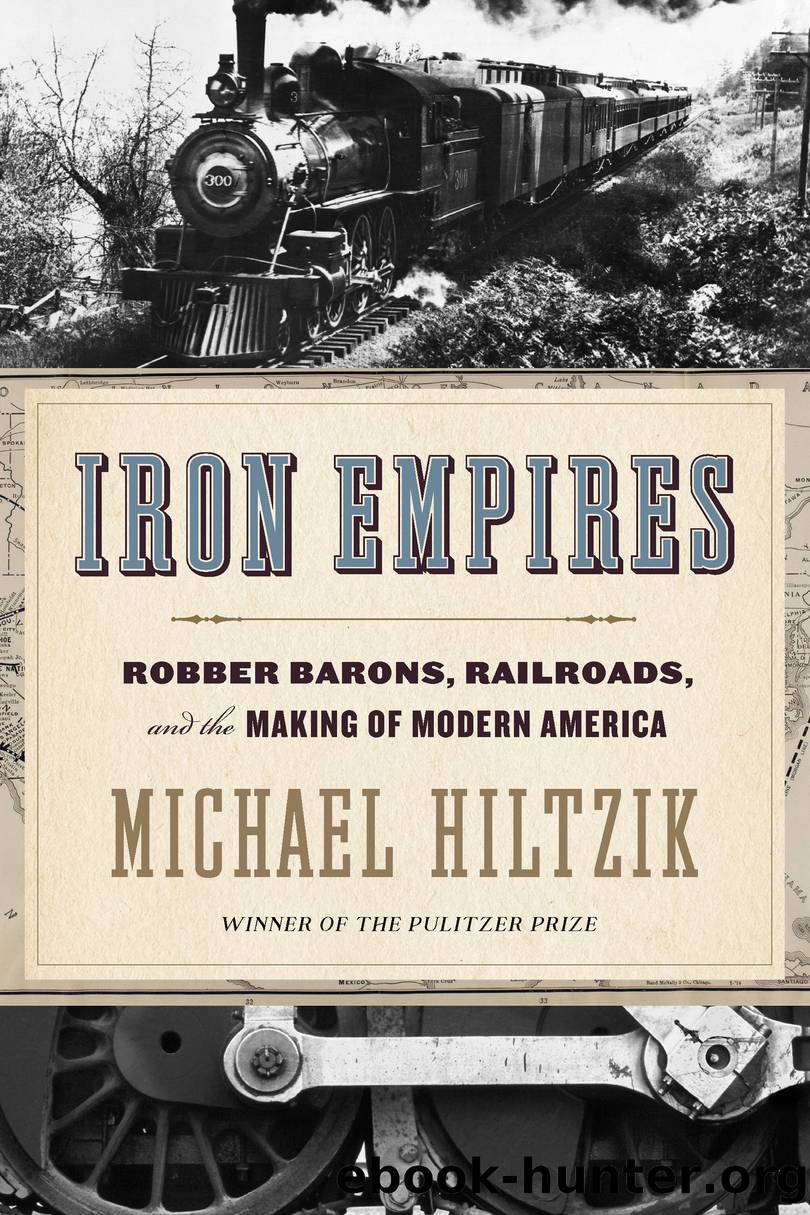Iron Empires by Michael Hiltzik

Author:Michael Hiltzik
Language: eng
Format: epub
ISBN: 9780544770348
Publisher: HMH Books
Published: 2020-08-11T00:00:00+00:00
* * *
* * *
The five other major railroad trusts were Vanderbilt’s, assembled around the New York Central and its tributaries; the Gould-Rockefeller group, the remnant of Jay Gould’s network, now managed mostly by William Rockefeller; the Pennsylvania Railroad group; the Rock Island; and Harriman’s, based on the Union Pacific and (after 1901) the Southern Pacific. But as Moody observed, the distinctions among these groups were not always clear-cut, for several had interconnections leading ultimately to Morgan: The Pennsylvania group had become allied with the Vanderbilts, thanks in part to Morgan’s own peacemaking, and the Vanderbilts were allied with Morgan. Then there were the ways that Morgan exerted his influence indirectly, through big banks such as the First National and Chase National and life insurance companies such as New York Life, all of which were at least partially under his control.
This was the community of interests in the flesh, and the flesh was Pierpont Morgan’s. Only Harriman, with an obstinate self-confidence that matched Morgan’s, stood apart. His goals did not differ from that of Morgan and his compatriots, but he would pursue them on his own.
The Morgan system would permanently alter the railroads’ relationship with their communities, passengers, and shippers. Under the new system, the quest for profits unfolded on a much greater scale than before. It was no longer possible for a lone buccaneer to plunder a single line in the style of Drew, Gould, and Fisk; henceforth, fortunes would be made and lost in battles waged by titans over ever-larger consolidated enterprises, with commensurately titanic consequences for the national economy and the financial markets.
The railroads’ customers would soon discover that this change substituted a new evil for the old one, and was much more costly at that. As Interstate Commerce Commissioner Charles A. Prouty told an economists’ conference in 1902, reflecting on a half decade of unprecedented upheaval: “Five years ago the crying evil in railway operations was . . . mainly discrimination between individual shippers. While many rates were too high, the general level was low.” That was no longer the case. As a result of the consolidation of the 1890s and the railroads’ recognition that “competition in rates is always suicidal,” competition had been eradicated. Rate discrimination had disappeared, “but in its place comes that other danger which always attends monopoly, the exaction of an unreasonable charge.” Put simply, the same shippers who earlier resented favoritism shown to their competitors, even if within an environment of lower rates for all, now discovered that the price of eliminating favoritism was the imposition of higher rates for everyone, with no opportunity for negotiation.
This stubbornness permeated the industry, not only in its relations with customers, but with its workers. As the century drew to a close, George Pullman, one of the most bullheaded men in American business, provoked a confrontation that would reverberate in US labor-management relations for decades to come. To passengers on long-distance train trips who passed the nights in his sleeping cars, Pullman’s name had been identified with comfort and luxury on the rails.
Download
This site does not store any files on its server. We only index and link to content provided by other sites. Please contact the content providers to delete copyright contents if any and email us, we'll remove relevant links or contents immediately.
| Africa | Americas |
| Arctic & Antarctica | Asia |
| Australia & Oceania | Europe |
| Middle East | Russia |
| United States | World |
| Ancient Civilizations | Military |
| Historical Study & Educational Resources |
The Bomber Mafia by Malcolm Gladwell(1184)
Submerged Prehistory by Benjamin Jonathan; & Clive Bonsall & Catriona Pickard & Anders Fischer(1162)
Facing the Mountain by Daniel James Brown(1135)
The Dawn of Everything by David Graeber & David Wengrow(1112)
The Way of Fire and Ice: The Living Tradition of Norse Paganism by Ryan Smith(1033)
Wandering in Strange Lands by Morgan Jerkins(1019)
Driving While Brown: Sheriff Joe Arpaio Versus the Latino Resistance by Terry Greene Sterling & Jude Joffe-Block(1003)
Tip Top by Bill James(1002)
Evil Geniuses: The Unmaking of America: A Recent History by Kurt Andersen(1001)
Red Roulette : An Insider's Story of Wealth, Power, Corruption, and Vengeance in Today's China (9781982156176) by Shum Desmond(1000)
F*cking History by The Captain(969)
It Was All a Lie by Stuart Stevens;(942)
White House Inc. by Dan Alexander(906)
Evil Geniuses by Kurt Andersen(903)
Treasure Islands: Tax Havens and the Men who Stole the World by Nicholas Shaxson(880)
American Dreams by Unknown(860)
American Kompromat by Craig Unger(849)
The Fifteen Biggest Lies about the Economy: And Everything Else the Right Doesn't Want You to Know about Taxes, Jobs, and Corporate America by Joshua Holland(817)
The First Conspiracy by Brad Meltzer & Josh Mensch(812)
